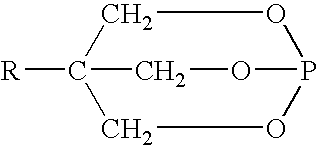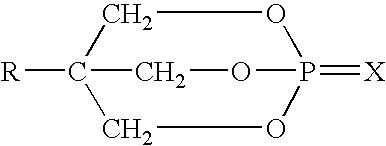Acid-methylol compound reaction products for flame resistance
a technology of acid-methylol and reaction products, which is applied in the direction of transportation and packaging, tyre parts, special tyres, etc., can solve the problems of difficult to achieve intumescence in practice, difficult to mix three or more ingredients well, and no universal recipe, etc., to achieve uniform distribution and suppress acidity
- Summary
- Abstract
- Description
- Claims
- Application Information
AI Technical Summary
Benefits of technology
Problems solved by technology
Method used
Image
Examples
example 1
[0088] Sample 4D in Table I was prepared by mixing 37.9 g melamine and 10.4 g paraformaldehyde in 170 g H.sub.2O and heated with stirring at 90 C. for about 15-30 minutes. In a separate vessel, eighteen grams of SAPP was dissolved in 150 g H.sub.2O. The next step was to add 60 g of ion exchange resin to remove sodium ions and make pyrophosphoric acid (PPA). The acid was filtered to remove the ion exchange resin. The resin was washed with 25 g H.sub.2O, with said wash water added to the PPA acid. Then slowly (over 3-5 minutes), the clear methylol melamine solution was added to the PPA acid solution. A white precipitate was formed nearly immediately as the second solution was added. The precipitate was filtered and dried, and then heated at 120.degree. C. for 30 minutes. The pH of the reaction product was approximately 5.1. Two g of the reaction product was heated in an oven at 500.degree. C. The char that formed was several times larger due to self-intumescence and thus demonstrated ...
example 2
Preparation of methylol melamine cyanurate (MMC)
[0106] 18.9 g of melamine and 4.4 g of paraformaldehyde with 202 g H.sub.2O were heated to approximately 100.degree. C. with stirring. A clear solution of methylol melamine was formed in about 20 minutes. In a separate beaker, 19.3 g. cyanuric acid (CA) was added to 125 g H.sub.2O and heated to about 80.degree. C. The hot methylol melamine solution was slowly added to the CA slurry over about 4 minutes maintaining good agitation. After about 30 minutes the reaction was complete and the pH of the final solution was about 4.7. The product was filtered and dried.
18 Id# Mel paraf H2O CA H2O pH Mc1 18.9 4.4 202 19.3 125 4.7
[0107] In table XVIII, the thermogravimetric (TGA) weight was tabulated as a function of temperature for melamine cyanurate (MC) and MMC. The heating rate was 10.degree. C. per minute for a nitrogen flow rate of 30 cubic centimeters / minute. Both samples did not begin to loose weight until the temperature had reached about...
example 3
Preparation of methylol melamine pentaerythritol phosphate
[0108] Mix 18.9 g (0.15 moles) melamine and 4.4 g of paraformaldehyde with 202 g H.sub.2O and heat to approximately 100.degree. C. with stirring. A clear solution of methylol melamine forms in about 20 minutes. Pentaerythritol phosphate is prepared separately according to U.S. Pat. No. 3,293,327. In a separate beaker, add 27 g pentaerythritol phosphate (0.15 moles) to 125 g H.sub.2O and heat to about 80.degree. C. Slowly add the hot methylol melamine solution to the pentaerytiritol phosphate over about 4 minutes maintaining good agitation. After about 30 minutes the reaction is complete and the pH of the final solution is about 4.7. Filter and dry the product.
PUM
| Property | Measurement | Unit |
|---|---|---|
| Fraction | aaaaa | aaaaa |
| Fraction | aaaaa | aaaaa |
| Percent by mass | aaaaa | aaaaa |
Abstract
Description
Claims
Application Information
 Login to View More
Login to View More - R&D
- Intellectual Property
- Life Sciences
- Materials
- Tech Scout
- Unparalleled Data Quality
- Higher Quality Content
- 60% Fewer Hallucinations
Browse by: Latest US Patents, China's latest patents, Technical Efficacy Thesaurus, Application Domain, Technology Topic, Popular Technical Reports.
© 2025 PatSnap. All rights reserved.Legal|Privacy policy|Modern Slavery Act Transparency Statement|Sitemap|About US| Contact US: help@patsnap.com



